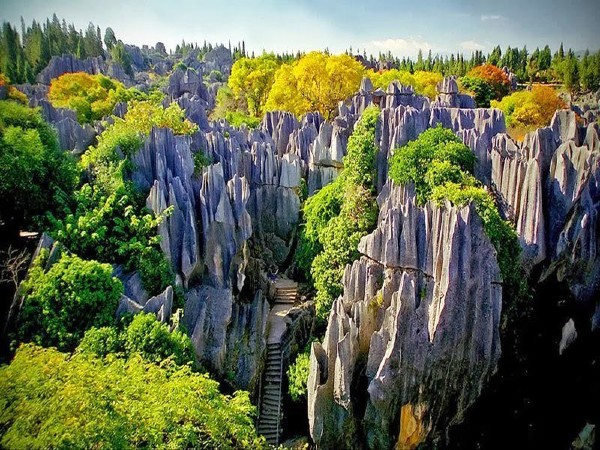Rhododendrons and camellias grow wild to profusion in the subtropical climate of China's south-western Yunnan province Kunming, the capital, is known as the City of Eternal Spring, and the area is a treasure house of plants and trees. But the forest that lies on a plateau 75 miles (120km) southeast of Kunming is not noted for trees - it is named for its forest of limestone pillars carved to strange shapes by time and the elements.
Lunan Stone Forest, which covers an area of about 2 sq miles (5 sq km), has countless stone pillars that range from about human height to a soaring 100ft (30m). Some look like clumps of bamboo, some like gigantic swords, and others like birds and beasts, giant mushrooms and Pagados. Describing them has stimulated the imagination of generations, as some of the allotted names reveal - 'Phoenix Preening its feathers', 'Layered Waterfall', 'Lion Arbour' and 'Lotus Blossom Peak'.

Some of the pillars are clustered together in their hundreds, while others stand in relative isolation. In the dark recesses between the pillars are pools, grottoes, and twisting passageways matted with vegetation.
Man-made footpaths thread their way between vertical rock walls and, with endless junctions dictated by the whims of the rock pattern, the paths form a maze that faces, their red and pink flowers adding a splash of colour to the scene.
Millions of years ago this fantastic forest was a solid bed of limestone. Earth movements lifted the rock bed to form a gently sloping plateau and broke up the limestone with a criss-cross of vertical fractures. Rainwater and soil water, charged with carbon dioxide from the plentiful vegetation, becomes a weak acid that is very effective at dissolving limestone, and the initial fractures soon enlarge to wide fissures. In the heart of the Stone Forest, much of the original bed of limestone is now gone, dissolved away by the acid, and the rest stands as sharp, fluted rock pinnacles.
Tiger Dance

Paddy fields border the forest fields, and local farmers use water buffaloes to draw the plough. The Sani people who live around the Stone Forest are a branch of the Yi - a minority of people within China. In late June each year, they hold a Torch Festival with singing and dancing, including a tiger dance with two men dressed as a tiger threatening women picking fruit; the beast is challenged by men with pitchforks.
One of the rocks of the Stone Forest, Ashima Rock, is named after Ashima, a beautiful Sani girl who, according to legend, was kidnapped by a wealthy landowner. Her lover, Ahai, armed with magic, set off in pursuit to rescue her. But tragedy struck - Ashima died and was turned into a rock. Now she waits for Ahai to come to her.
Folk legend also has an explanation for the creation of the Stone Forest. It is accredited to Zhang Guolao, one of the eight Chinese Immortals. The kindly sage was one day riding a donkey across the huge plain when he came upon couples courting in the open.



 Click it and Unblock the Notifications
Click it and Unblock the Notifications






















